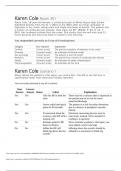Samenvatting
Samenvatting Chapter 15 Oxford Handbook Gender in Organizations
- Instelling
- Radboud Universiteit Nijmegen (RU)
The Oxford Handbook of Gender in Organizations Chapter 15: Power and resistance in gender equality strategies: comparing quotas and small wins. Yvonne Benschop and Marieke van den Brink Summary
[Meer zien]














